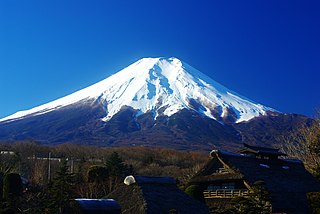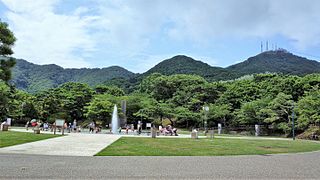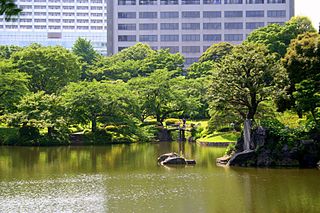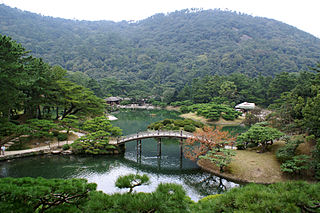 W
WAmanohashidate (天橋立) is one of Japan's three scenic views. The sandbar is located in Miyazu Bay in northern Kyoto Prefecture. It forms part of the Tango-Amanohashidate-Ōeyama Quasi-National Park.
 W
WDaisen-in (大仙院) is a sub-temple of Daitoku-ji, a temple of the Rinzai school of Zen in Buddhism, one of the five most important Zen temples of Kyoto. The name means "The Academy of the Great Immortals." Daisen-in was founded by the Zen priest Kogaku Sōkō (古岳宗亘) (1464–1548), and was built between 1509 and 1513. Daisen-in is noted for its screen paintings and for its kare-sansui, or dry landscape garden.
 W
WMount Fuji , located on the island of Honshū, is the highest mountain in Japan, standing 3,776.24 m (12,389.2 ft). It is the second-highest volcano located on an island in Asia, and seventh-highest peak of an island on Earth. Mount Fuji is an active stratovolcano that last erupted from 1707 to 1708. The mountain is located about 100 km (62 mi) southwest of Tokyo and is visible from there on clear days. Mount Fuji's exceptionally symmetrical cone, which is covered in snow for about five months of the year, is commonly used as a cultural icon of Japan and it is frequently depicted in art and photography, as well as visited by sightseers and climbers.
 W
WGinkaku-ji , officially named Jishō-ji , is a Zen temple in the Sakyo ward of Kyoto, Japan. It is one of the constructions that represents the Higashiyama Culture of the Muromachi period.
 W
WHakodate Park is a large Western-style park in Hakodate, Hokkaidō, Japan, at the foot of Mount Hakodate. Opened in 1879, it is a registered as a "place of scenic beauty" in Japan's Law for the Protection of Cultural Properties. It contains the Hakodate City Museum, as well as a small zoo and children's theme park, and is a popular site for cherry blossom viewing.
 W
WHama-rikyū Gardens is a public park in Chūō ward, Tokyo, Japan. Located at the mouth of the Sumida River, it was opened to the public on April 1, 1946. A landscaped garden of 250,216 m² includes Shio-iri Pond, and the park is surrounded by a seawater moat filled by Tokyo Bay. It was remodeled as a public park on the site of a villa belonging to the ruling Tokugawa family in the 17th century.
 W
WHeijō Palace was the imperial residence in the Japanese capital city Heijō-kyō, during most of the Nara period. The palace, which served as the imperial residence and the administrative centre of for most of the Nara period from 710 to 794 AD, was located at the north-central location of the city in accordance with the Chinese models used for the design of the capital.
 W
WHeijō-kyō , was the Capital of Japan during most of the Nara period, from 710–40 and again from 745–84. The imperial palace is a listed UNESCO World Heritage together with other places in the city of Nara.
 W
WThe Ichijōdani Asakura Family Historic Ruins are historic ruins located in the Kidonouchi section of the city of Fukui, Fukui Prefecture, in the Hokuriku region of Japan. This area was controlled by the Asakura clan for 103 years during the Sengoku period. It is designated as Special Historic Site in 1971, and in June 2007 2,343 artifacts were designated as Important Cultural Property.
 W
WItsukushima (厳島) is an island in the western part of the Inland Sea of Japan, located in the northwest of Hiroshima Bay. It is popularly known as Miyajima (宮島), which in Japanese means "Shrine Island". The island is one of Hayashi Gahō's Three Views of Japan specified in 1643. Itsukushima is part of the city of Hatsukaichi in Hiroshima Prefecture. The island was part of the former town of Miyajima before the 2005 merger with Hatsukaichi.
 W
WJōruri-ji (浄瑠璃寺) is a temple of the Shingon Ritsu school with an historic Japanese garden located in Kizugawa, Kyoto Prefecture, Japan. It is one of the few remaining examples of a Paradise Garden of the early Heian period. The three-storied pagoda, the main hall, the group of nine sitting Amida Nyorai statues and the group of Four Heavenly Kings are all designated as National Treasures. The temple is heavily influenced by Pure Land thought.
 W
WKamikōchi is a remote mountainous highland valley within the Hida Mountains range, in the western region of Nagano Prefecture, Japan.
 W
WKenroku-en, located in Kanazawa, Ishikawa, Japan, is an old private garden. Along with Kairaku-en and Kōraku-en, Kenroku-en is one of the Three Great Gardens of Japan. The grounds are open year-round except for December 29 through January 3 during daylight hours and famous for its beauty in all seasons; an admission fee is charged.
 W
WKinkaku-ji , officially named Rokuon-ji , is a Zen Buddhist temple in Kyoto, Japan. It is one of the most popular buildings in Kyoto, attracting many visitors annually. It is designated as a National Special Historic Site, a National Special Landscape and is one of 17 locations making up the Historic Monuments of Ancient Kyoto which are World Heritage Sites.
 W
WThe Koishikawa Kōrakuen (小石川後楽園) is a large urban park in the Koishikawa neighborhood of Bunkyō, Tokyo, Japan. The Japanese garden dates from the early Edo period. and is one of three surviving daimyō gardens of the many that were created during that period, the others being the Rikugi-en and the Hama Rikyū gardens.
 W
WKonchi-in (金地院) is a Buddhist temple in Sakyō-ku, Kyoto, western Japan.
 W
WKōraku-en is a Japanese garden located in Okayama, Okayama Prefecture. It is one of the Three Great Gardens of Japan, along with Kenroku-en and Kairaku-en. Korakuen was built in 1700 by Ikeda Tsunamasa, lord of Okayama. The garden reached its modern form in 1863.
 W
WMatsushima (松島) is a group of islands in Miyagi Prefecture, Japan. There are some 260 tiny islands (shima) covered in pines (matsu) – hence the name – and is ranked as one of the Three Views of Japan.
 W
WMonuments is a collective term used by the Japanese government's Law for the Protection of Cultural Properties to denote Cultural Properties of Japan as historic locations such as shell mounds, ancient tombs, sites of palaces, sites of forts or castles, monumental dwelling houses and other sites of high historical or scientific value; gardens, bridges, gorges, mountains, and other places of great scenic beauty; and natural features such as animals, plants, and geological or mineral formations of high scientific value.
 W
WMōtsū-ji (毛越寺) is a Buddhist temple of the Tendai sect in the town of Hiraizumi in southern Iwate Prefecture, Japan, and also refers to the historic area surrounding it containing the ruins of two older temples, Enryū-ji (圓隆寺) and Kashō-ji (嘉祥寺) in a Jōdo garden. The current temple was built in the 18th century and bears no relation to the ancient temple structures that once stood here. In June 2011, Mōtsū-ji was listed as a UNESCO World Heritage Site as "Historic Monuments and Sites of Hiraizumi".
 W
WNijō Castle is a flatland castle in Kyoto, Japan. The castle consists of two concentric rings (Kuruwa) of fortifications, the Ninomaru Palace, the ruins of the Honmaru Palace, various support buildings and several gardens. The surface area of the castle is 275,000 square metres, of which 8,000 square metres (86,000 sq ft) is occupied by buildings.
 W
WŌmishima Island is the largest island in the Geiyo Islands chain, and the westernmost which accommodates the Nishiseto Expressway between Honshu and Shikoku. It is located in the Seto Inland Sea. The island's highest peak is Washigatozan (鷲ヶ頭山) at an altitude of 437 m (1,434 ft).
 W
WRikugi-en Gardens are a Tokyo metropolitan park in Bunkyō-ku. The name Rikugi-en means Garden of the Six Principles, referring to the six elements in waka poetry, based on the traditional division of Chinese poetry into six categories. The gardens consist of a small pond, trees, and a hill.
 W
WRitsurin Garden is a large, historic garden in Takamatsu, Japan. It was completed in 1745 as a private strolling garden and villa for the local feudal lords, and opened to the public in 1875. Ritsurin is one of the largest strolling gardens in Japan, and a major tourist attraction for Kagawa Prefecture.
 W
WRyōan-ji is a Zen temple located in northwest Kyoto, Japan. It belongs to the Myōshin-ji school of the Rinzai branch of Zen Buddhism. The Ryōan-ji garden is considered one of the finest surviving examples of kare-sansui, a refined type of Japanese Zen temple garden design generally featuring distinctive larger rock formations arranged amidst a sweep of smooth pebbles raked into linear patterns that facilitate meditation. The temple and its gardens are listed as one of the Historic Monuments of Ancient Kyoto, and as a UNESCO World Heritage Site.
 W
WSaihō-ji (西芳寺) is a Rinzai Zen Buddhist temple in Matsuo, Nishikyō Ward, Kyoto, Japan. The temple, which is famed for its moss garden, is commonly referred to as "Koke-dera" (苔寺), meaning "moss temple", while the formal name is "Kōinzan Saihō-ji" (洪隠山西芳寺). The temple, primarily constructed to honor Amitābha, was first founded by Gyōki and was later restored by Musō Soseki. In 1994, Saihō-ji was registered as a UNESCO World Heritage Site, as part of the "Historic Monuments of Ancient Kyoto". Over 120 types of moss are present in the two-tiered garden, resembling a beautiful green carpet with many subtle shades.
 W
WSanbō-in is a Buddhist temple in southern Kyoto, Japan, known today primarily for the quality of its garden.
 W
WSandan-kyō is a 16-kilometer long ravine in the Nishi-Chugoku Sanchi Quasi-National Park in Akiota, Hiroshima, Japan. Through it runs the Shibaki River, one of the Ōta River's tributaries. Sandan-kyō is known for its autumn foliage.
 W
WThe gardens of Shikina-en (識名園) are located on a small hill to the south of Shuri Castle in Naha, Okinawa. The residence and its gardens are also known as Shichina-nu-Udun (シチナヌウドゥン) or Southern Gardens (南苑), as opposed to the Eastern Gardens (東苑) or Uchayaudun (御茶屋御殿), laid out on a small hill east of Shuri Castle in 1677. In 1992 Hiroshi Shō, the great-grandson of Shō Tai, the last king of the Ryūkyū Kingdom, donated the royal mausoleum of Tamaudun and Shikina-en to the City of Naha.
 W
WTenryū-ji (天龍寺), formally known as Tenryū Shiseizen-ji (天龍資聖禅寺), is the head temple of the Tenryū-ji branch of the Rinzai sect of Zen Buddhism, located in Susukinobaba-chō, Ukyō Ward, Kyoto, Japan. The temple was founded by Ashikaga Takauji in 1339, primarily to venerate Gautama Buddha, and its first chief priest was Musō Soseki. Construction was completed in 1345. As a temple related to both the Ashikaga family and Emperor Go-Daigo, the temple is held in high esteem, and is ranked number one among Kyoto's so-called Five Mountains. In 1994, it was registered as a UNESCO World Heritage Site, as part of the "Historic Monuments of Ancient Kyoto".
 W
WTensha-en is a Japanese garden located in Uwajima, Ehime south of Uwajima Castle. Built by Date Munetada, the 7th lord in the Date clan, in 1866, it is one of the last gardens built by a daimyo. In 1672, the 2nd lord of Uwajima, Date Munetoshi, reclaimed land from the sea for the lord's palace which eventually became the site of the garden. Tensha-en is an example of borrowed scenery, framed by Mount Onigajo and the surrounding mountain range. It includes a pond in the shape of the kanji for 'heart' (心) and features a calligraphy room called Harusametei (春雨亭) in the center of the garden. It is adjacent to the Uwajima City Date Museum, southwest of Uwajima Castle.
 W
WLake Towada is the largest crater lake in Honshū island, Japan. Located on the border between Aomori and Akita prefectures, it lies 400 meters (1,800 ft) above sea level and is 327 m (1,073 ft) deep, drained by the Oirase river. With a surface area of 61.1 km², Towada is Japan's 12th largest lake, its bright blue color is due to its great depth. The lake is roughly circular, with two peninsulas extending from its southern shore approximately one-third into the center of the lake. The lake is a popular tourist destination.
 W
WMount Unzen is an active volcanic group of several overlapping stratovolcanoes, near the city of Shimabara, Nagasaki on the island of Kyushu, Japan's southernmost main island.